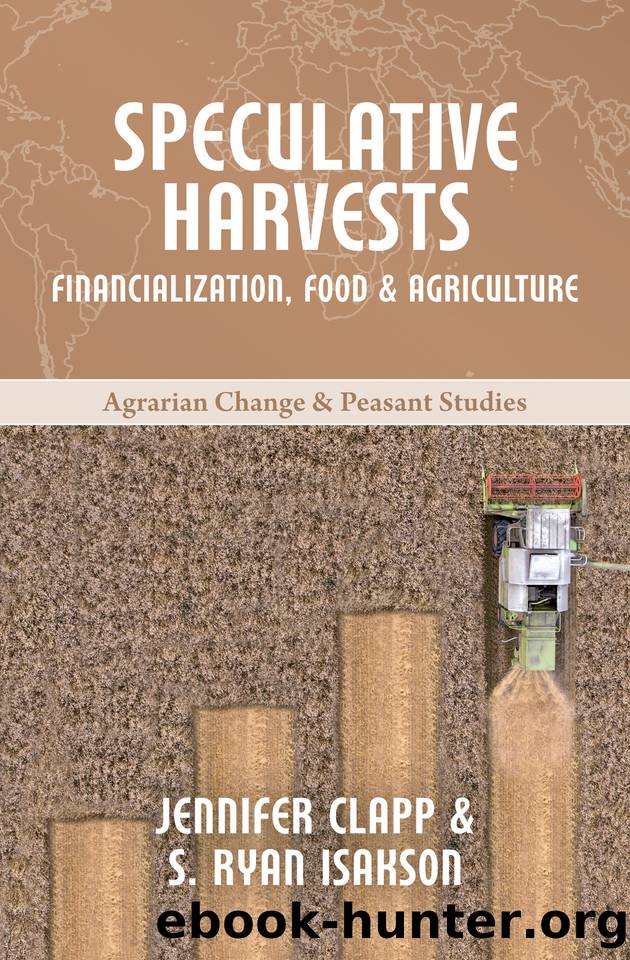Speculative Harvests: Financialization, Food, and Agriculture by Isakson S. Ryan & Clapp Jennifer

Author:Isakson, S. Ryan & Clapp, Jennifer [Isakson, S. Ryan]
Language: eng
Format: epub
Publisher: Practical Action Publishing Ltd
Published: 2018-04-29T16:00:00+00:00
Assembling Farmland as an Asset Class
Specialized investment companies provide a variety of channels for actors who wish to invest in farmland, including compiling a portfolio of properties, managing the leases of tenant farmers, servicing mortgages on farmland, directly engaging in agricultural production, or some combination of the above (Desmarais et al. 2017). Fairbairn (2014) classifies the strategies pursued by investment companies into three broad models: “own lease-out,” “lease operate,” and “own operate.” Each model offers varying degrees of exposure to farmland as a productive resource and farmland as a store of value, thus appealing to different types of financial actors (Knuth 2015).
The “own lease-out” model is most in line with understandings of land as a financial asset. Under this strategy, investors acquire farmland and then rent it to tenant farmers; their interest is in the potential of land values to appreciate and rental profits, not agricultural production. It provides the security of land ownership while offloading the risks of agricultural production and volatile commodity prices onto independent farmers. By contrast, the “lease operate” model provides no such guarantees. Instead, an investment company that is primarily interested in the productive attributes of farmland, and is willing to assume the associated risks, rents the land and either directly engages in agricultural production or hires a farm management enterprise to do so on its behalf. Under the third strategy, “own operate,” investors gain exposure to both the financial and productive features of farmland and the attendant risks and benefits. The specific form that investments take will vary according to the institutional context and motives of asset managers and investors (Magnan 2015).
Regardless of the model pursued, the peculiarities of farmland complicate efforts to mould it into an asset class. Whereas conventional asset classes, like stocks, bonds, and even commodity futures, can be easily traded and have relatively homogenous qualities, farmland is immobile and heterogeneous; its transactions are complicated and can be politically contentious. Several scholars discuss the challenges of transforming land into a financial asset and identify a number of requisite conditions for doing so (Haila 1988; Coakley 1994; Li 2014; Ouma 2016; Visser 2017; Ducastel and Anseeuw 2017). The two main ones are (1) the development of standardized metrics that render land legible to investors and (2) initiatives to facilitate transactions of land-based investments (i.e., improve their liquidity).
Land is notoriously illiquid. It is a source of multiple privileges and benefits that can be understood as “priceless” and limit its supply in markets. Land can take various shapes and sizes, and the rights over its control are often overlapping and rooted in place-based political and cultural histories, some of which are more conducive to market exchange than others. Formatting land for financial purposes requires the erasure of its history and nonmarket values and meanings. It also requires translating the qualitative differences that define each plot—variables like soil quality, climatic conditions, access to water, slope, location, proximity to infrastructure, etc.—into standardized benchmarks that are intelligible to investors and allow them to evaluate the relative merits of different land-based investment vehicles (Li 2014; Visser 2017; Ducastel and Anseeuw 2017).
Download
This site does not store any files on its server. We only index and link to content provided by other sites. Please contact the content providers to delete copyright contents if any and email us, we'll remove relevant links or contents immediately.
Craft Beer for the Homebrewer by Michael Agnew(18146)
Marijuana Grower's Handbook by Ed Rosenthal(3624)
Barkskins by Annie Proulx(3314)
Project Animal Farm: An Accidental Journey into the Secret World of Farming and the Truth About Our Food by Sonia Faruqi(3178)
The Plant Messiah by Carlos Magdalena(2883)
Red Famine: Stalin's War on Ukraine by Anne Applebaum(2874)
0041152001443424520 .pdf by Unknown(2786)
Organic Mushroom Farming and Mycoremediation by Tradd Cotter(2631)
In the Woods by Tana French(2534)
Beer is proof God loves us by Charles W. Bamforth(2377)
7-14 Days by Noah Waters(2362)
Reservoir 13 by Jon McGregor(2242)
Borders by unknow(2232)
Meathooked by Marta Zaraska(2221)
The Art of Making Gelato by Morgan Morano(2218)
Birds, Beasts and Relatives by Gerald Durrell(2179)
Between Two Fires by Christopher Buehlman(2174)
The 7 Habits of Highly Effective People: Powerful Lessons in Personal Change (25th Anniversary Edition) by Covey Stephen R(2141)
The Lean Farm Guide to Growing Vegetables: More In-Depth Lean Techniques for Efficient Organic Production by Ben Hartman(2099)
